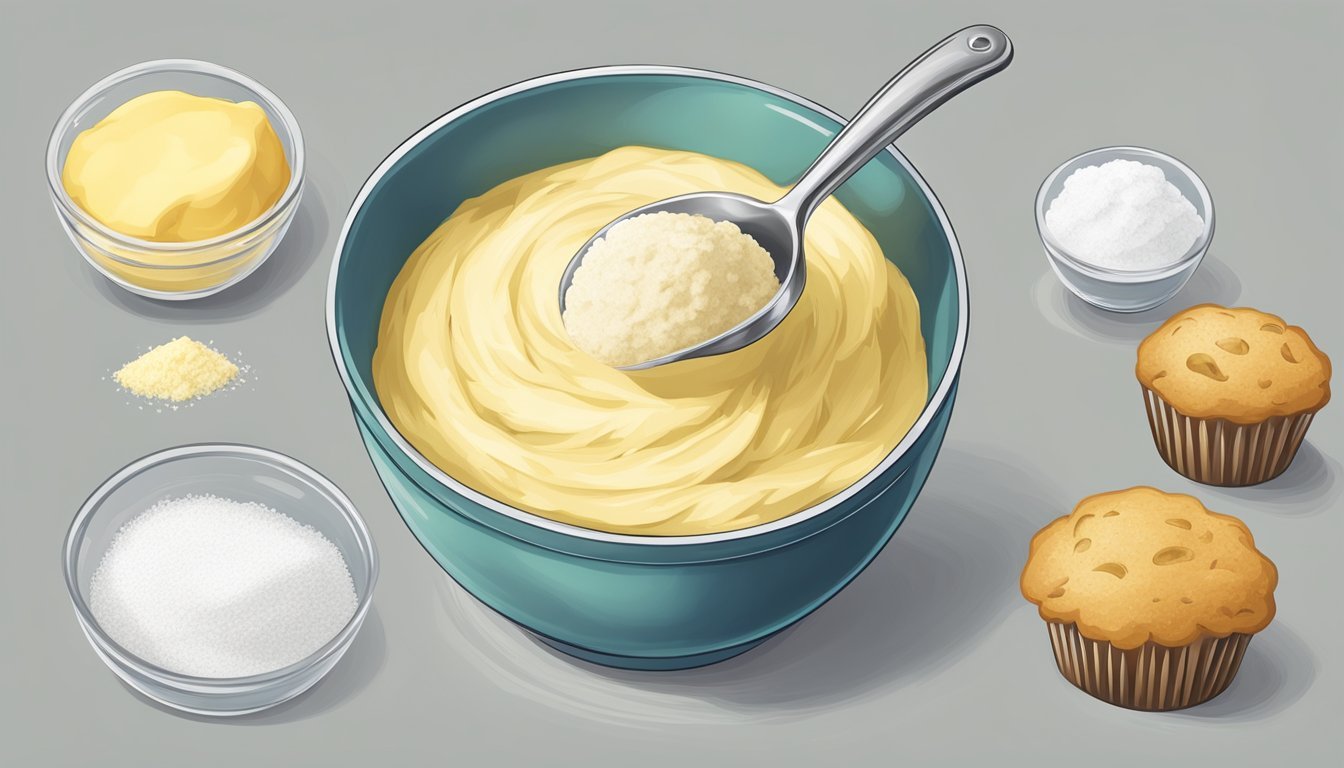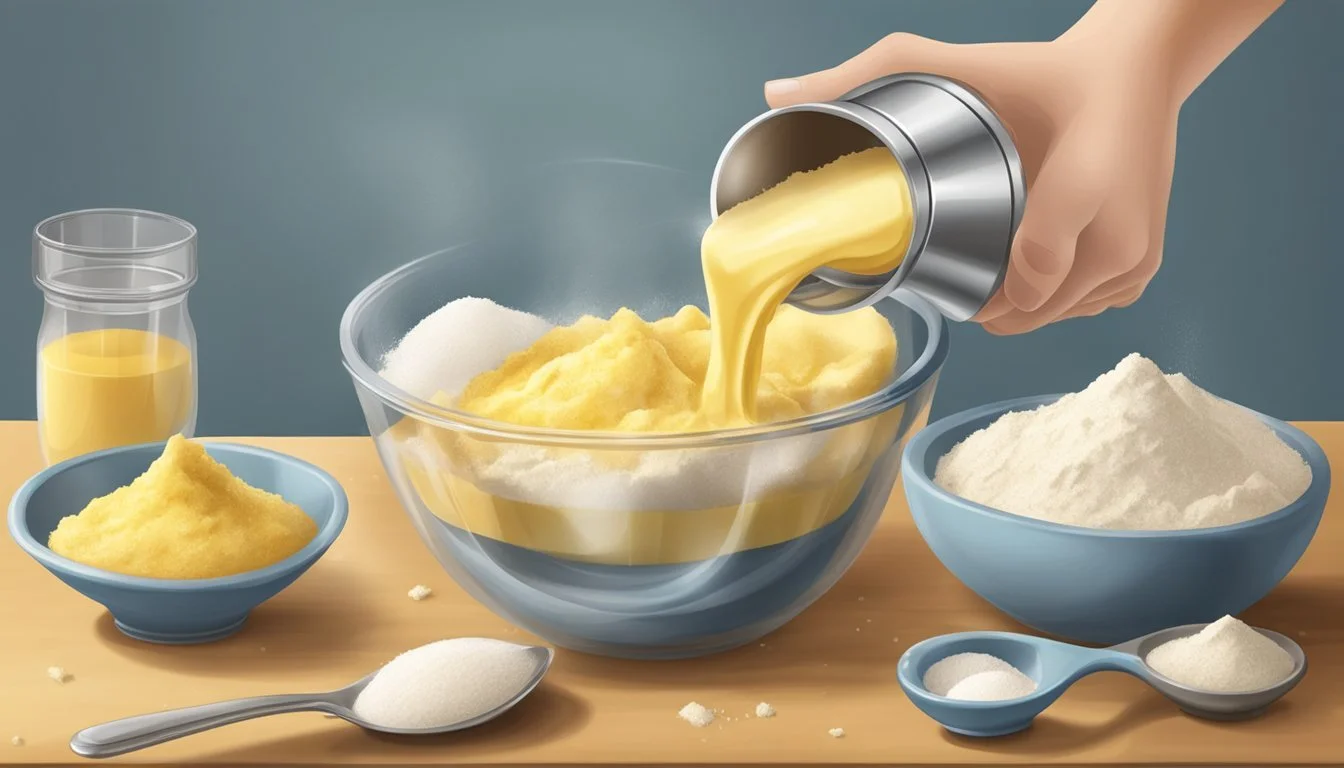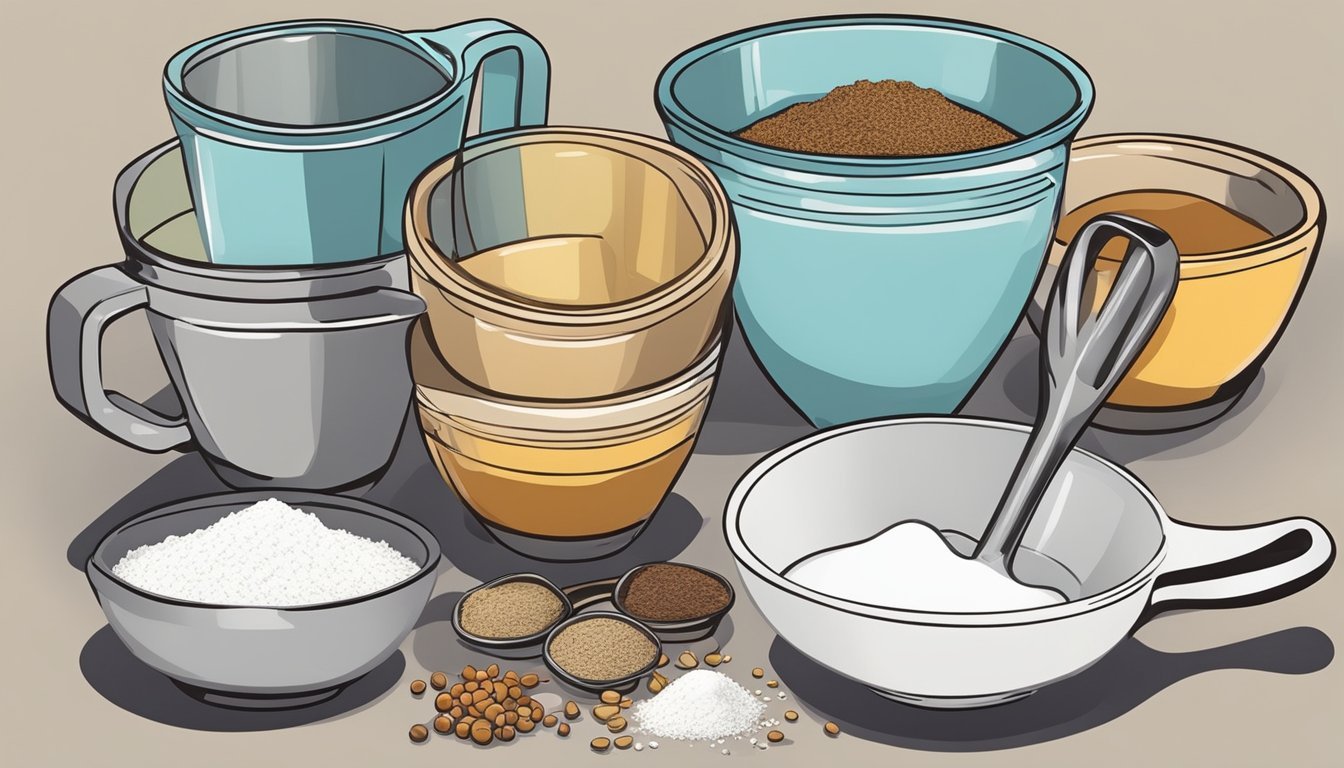How to Measure Ingredients for a Homemade Muffin Topping
A Precision Guide
Measuring ingredients accurately is essential when crafting a homemade muffin topping. The right proportions ensure a perfect balance of flavor and texture. For streusel, which is a popular crumbly topping, it includes a mixture of flour, sugar, and butter that requires precise measuring to achieve the desired consistency. Using standard measuring cups for dry ingredients like flour and sugar, and liquid measuring cups for melted butter, yields the best results. A key tip for dry ingredients is to spoon them into the measuring cup and level it off with a straight edge to avoid excess, which can lead to a dense topping.
In the case of brown sugar, which is often used for its rich molasses flavor in toppings such as streusel, it's crucial to pack it firmly into the measuring cup so it holds its shape when turned out. This method ensures that each batch of muffin topping has just the right amount of sweetness. For butter, which binds the dry ingredients and contributes to the crumbly texture of the streusel, solid butter should be cut into small pieces before being blended with the sugar and flour mixture. If melted butter is used, it should be measured in liquid measuring cups to provide accurate liquid volume.
Once all the ingredients are measured and mixed, the topping can be sprinkled over the muffin batter before baking. The accurate measurement of components doesn't just dictate the texture; it also significantly affects the flavor distribution and the overall baking experience. Ensuring meticulous measurement facilitates a topping that complements the muffin without overwhelming it — a harmonious blend of crunch, sweetness, and flavor that elevates the overall taste.
Understanding Muffin Toppings
Muffin toppings can transform a simple baked good into a gourmet delight. Two primary categories to consider are streusel toppings for a textured finish and a variety of other toppings that cater to different taste preferences.
Defining Streusel
Streusel topping involves a crumbly mixture of flour, sugar, and butter, occasionally seasoned with cinnamon or vanilla to enhance the flavor. It is prepared by mixing these ingredients until a sandy texture is achieved. For a successful streusel topping:
Butter: Use cold butter cut into small pieces.
Sugar: Brown sugar adds a caramelized taste while white sugar provides sweetness.
Flour: Plain all-purpose flour creates the structure.
Flavorings (optional): Cinnamon, nutmeg, or vanilla can be included for extra taste.
Variations of Muffin Toppings
Beyond streusel, muffins can be adorned with various toppings before or after baking. Ingredients range from coarse types of sugar that add crunch and texture to fruit compotes that contribute moisture and tanginess. Examples include:
Coarse Sugar: Turbinado or demerara sugar sprinkled on top before baking creates a sweet crust.
Nuts and Seeds: Walnuts, almonds, or pumpkin seeds offer a nutritious crunch.
Fruit Compote: A mix of berries, sugar, and lemon juice for a fresh, tangy complement.
Simple Glazes: Confectioners' sugar and milk or lemon juice, drizzled on cooled muffins.
One applies these toppings at different stages during the muffin-making process, depending on whether they are meant to bake onto the muffin or garnish it post-baking.
Essential Ingredients and Substitutions
When making a muffin topping, the perfect blend of ingredients and potential substitutions are critical for achieving the desired taste and texture.
Types of Flour
Flour is the foundation of any muffin topping, providing structure. All-purpose flour is commonly used for its reliable results, but one can substitute with whole wheat flour for a nuttier flavor or gluten-free flour for dietary needs — keeping the measure the same, one-for-one.
Sugars and Sweeteners
Brown sugar is prized in toppings for its moistness and deep flavor due to molasses. However, if unavailable, one can use an equal amount of white sugar or a combination of white sugar and molasses. Sweeteners like coconut sugar also work but may alter the flavor profile.
Butter: Cold or Melted
For streusel toppings, cold, cubed butter is essential as it helps create that crumbly texture when cut into the flour and sugar mix. Melted butter can create a denser topping, and while it's not traditional, it may be used if a crumbly texture is not the goal.
Salt and Spices
A pinch of salt enhances the flavors of the topping. Add spices such as cinnamon or nutmeg to complement the muffin's flavor. Begin with 1 teaspoon of cinnamon or 1/4 teaspoon of nutmeg per cup of flour, then adjust to taste.
Additional Mix-ins
Nuts like walnuts or pecans add a nice crunch to muffin toppings. One can add a handful, typically 1/4 to 1/2 cup, to the topping mixture. If allergies are a concern, seeds like pumpkin or sunflower can be used as alternatives.
Measuring Techniques
The success of a homemade muffin topping hinges on proper measuring techniques, ensuring that each ingredient contributes its intended flavor and texture.
Dry vs. Wet Ingredients
When measuring dry ingredients for a muffin topping, such as measure for measure flour or brown sugar, one must use nested measuring cups often coming in 1 cup, 1/2 cup, 1/3 cup, and 1/4 cup sizes. The cook should gently spoon the ingredient into the measuring cup without compacting it. For an even surface, they should level off the excess with the flat edge of a knife. When measuring sticky dry ingredients like brown sugar, packing it into the cup is typically required for accuracy.
Wet ingredients, however, demand a different approach. It is important to use a clear measuring cup designated for liquids and check for accuracy at eye level. Ingredients should be poured in up to the correct mark, ensuring they are measured out at a flat surface to prevent inaccuracies.
Precision in Measuring
Achieving precision is crucial when it comes to ingredients like baking powder or baking soda, as even slight deviations can notably affect the outcome.
Using Spoons for Small Amounts:
For amounts less than 1/4 cup, use measuring spoons.
To measure 3/4 teaspoon, combine 1/2 teaspoon and 1/4 teaspoon for accuracy.
Weighing for Consistency:
For precise baking, digital scales can be utilized, measuring ingredients to the gram.Sprinkle Method:
To prevent dry ingredients like flour from clumping or altering the texture, they should be sprinkled into the measuring device rather than scooped.
The cook should select the appropriate method for each type of ingredient to ensure the best results for their muffin topping.
Preparing the Muffin Batter
Before diving into combining ingredients for muffin batter, one should understand that muffin batter preparation is pivotal to the texture and rise of the muffins. The process involves careful measurement and mixing techniques to incorporate air, ensure even distribution of ingredients, and avoid overmixing.
Combining Wet and Dry Ingredients
To start, they should segregate wet ingredients (such as eggs and milk) from dry ingredients (including flour, baking powder, and other dry elements). In one bowl, they will whisk together the flour, baking powder, and any other dry ingredients until they are well combined. This ensures that the baking powder, which is crucial for the rise of the muffin, is evenly distributed throughout the batter.
In a separate bowl, the wet ingredients are mixed together until they are homogenous. A key to successful muffin batter is to make sure that components like eggs and milk are at room temperature to better integrate with the dry mixture.
Achieving the Right Consistency
One then combines the wet and dry mixtures, folding them together gently with a spatula or wooden spoon. It's important to mix just until the dry ingredients are moistened. The batter should be lumpy; if it's overmixed, the muffins can become dense.
Ingredient Purpose Texture Contribution Eggs Binder Adds structure Milk Moisture Promotes tender crumb Baking Powder Leavening Creates rise
They should avoid overmixing as not to deflate the air incorporated in the batter, which is crucial for proper texture. Once they achieve a batter that is thick and appropriately lumpy, it is ready to be spooned into the muffin tin for baking.
Assembling and Baking Muffins
When assembling and baking muffins, one must meticulously fill the muffin cups, add streusel topping for a crunchy texture, and carefully manage the oven temperature and baking time to ensure a perfectly baked muffin top.
Filling Muffin Cups
To ensure uniform muffins, use a scoop or spoon to fill muffin cups two-thirds full with batter. This allows room for the muffin to rise without spilling over. Fill each cup with the same amount of batter to guarantee even baking.
Topping with Streusel
For a delectable streusel topping, evenly sprinkle the mixture over the batter-filled muffin cups. The streusel should be coarse, like small pebbles, to create a crunchy topping that contrasts with the soft muffin beneath.
Oven Temperature and Baking Time
Preheat the oven to the appropriate temperature before inserting muffins; many recipes require a high initial temperature to help the muffin top rise. The temperature generally ranges from 350°F to 425°F. Baking time varies but is typically between 18-25 minutes. Muffins are done when they're golden brown on top and a toothpick inserted into the center comes out clean.
Storing and Freezing
When creating muffin toppings at home, maintaining their quality through proper storage is crucial. Handling both freshness in the short term and freezing for longevity can ensure the toppings retain their optimal texture and flavor.
Preserving Freshness
For immediate use, one should store muffin toppings in an airtight container at room temperature. The key to preserving freshness is controlling moisture levels, as excess moisture can make toppings soggy and impact their quality. To mitigate this, line the container with paper towels that can absorb any excess moisture.
Temperature: Room temperature is ideal for a day or two.
Moisture: Use paper towels to soak up condensation.
Containers should be kept in a dry, cool spot away from direct sunlight to prevent any heat-induced degradation of the topping's texture and taste.
Long-term Storage Tips
For extended storage, freezing is the best option. Muffin toppings can be stored in the freezer, where the low temperature halts bacterial growth and preserves the integrity of the topping for longer periods.
Steps for Freezing Muffin Toppings:
Place toppings in a single layer on a baking sheet.
Freeze until solid to prevent them from sticking together.
Transfer to a freezer-safe airtight container or a heavy-duty freezer bag.
Label with the current date for reference. Toppings can be stored for up to three months without significant loss of quality.
When it comes to thawing, a gentle approach is recommended to avoid introducing too much moisture too quickly. One can thaw the toppings in the refrigerator or at room temperature depending on the urgency and type of topping.
Temperature: Maintain a consistent freezer temperature of 0°F (-18°C).
Moisture: Ensure the container is sealed tightly to prevent freezer burn.
Recipe Adjustments and Tips
Adjusting a recipe to suit dietary needs or personal taste preferences is key in creating the perfect homemade muffin topping. This section provides specific guidance on customizing your toppings to enhance muffins both in flavor and presentation.
Gluten-Free and Vegan Options
For a gluten-free topping, one can substitute all-purpose flour with a gluten-free blend. To ensure cohesion in the mixture, it is also advisable to add a small amount of xanthan gum if the blend doesn't include it. Vegan variations are similarly achievable by opting for plant-based butter and ensuring any additional items like granola are free from animal products.
Flavor and Texture Enhancements
To enhance flavor and texture:
Sweetness: Brown sugar can add a richer, more caramel-like sweetness compared to regular sugar.
Crunch: Incorporate rolled oats or granola into the topping for an added crunch.
Spices: Cinnamon is a common choice for spicing up toppings, but nutmeg or ginger can also add depth.
Moistness: To maintain a moist topping, avoid overmixing the crumble which can lead to a dense texture.
Serving and Presentation Suggestions
Presentation can transform the simple muffin into a gourmet treat. Here are ways to elevate the aesthetic:
Sugars: A sprinkle of raw or turbinized sugar adds texture and a professional finish.
Toppings: Fresh fruits or a dollop of flavored butter can be added post-baking for an extra touch.
Portioning: Use an ice cream scoop for consistent and even topping portions across muffins.
Additional Notes
When crafting the perfect homemade muffin topping, one must be mindful of the balance between precision and creativity. This section provides guidance to ensure that the streusel is crumbly, flavorful, and used effectively.
Common Mistakes to Avoid
Incorrect Measurements: Using incorrect amounts of flour, sugar, or butter can lead to a topping that doesn't provide the desired texture. A kitchen scale can yield more accurate results than measuring cups.
Overworking the Mixture: Combining the ingredients until they're just mixed will maintain the crumbly texture of the streusel. Over-mixing may result in a paste rather than a crumble.
Creative Ideas for Leftover Streusel
Freeze for Later: Unused streusel can be stored in a freezer-safe bag or container. Label with the date prepared for future reference.
Versatile Applications: Consider using leftover streusel as a crunchy addition to oatmeal, yogurt, or ice cream for an unexpected twist.










